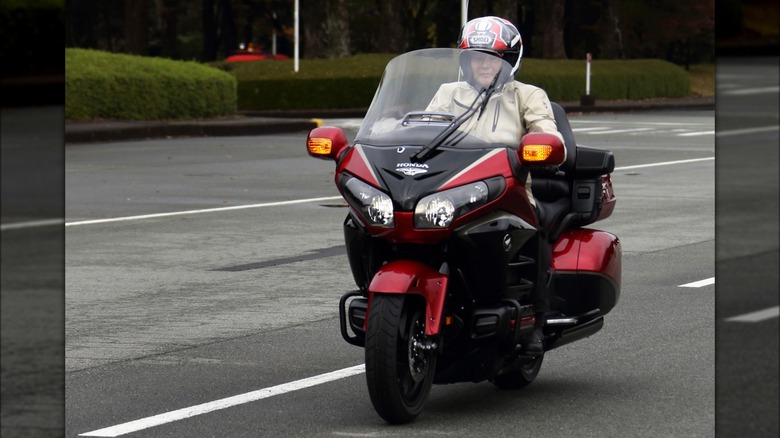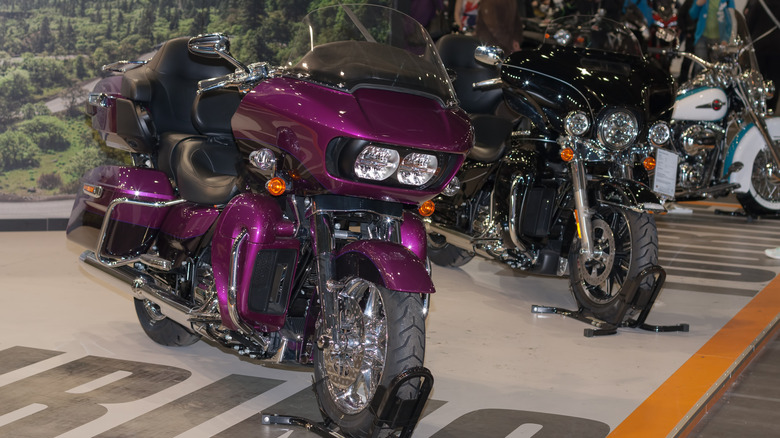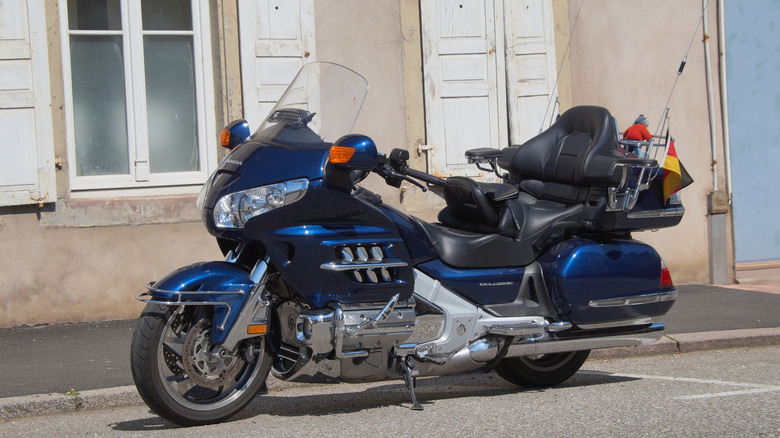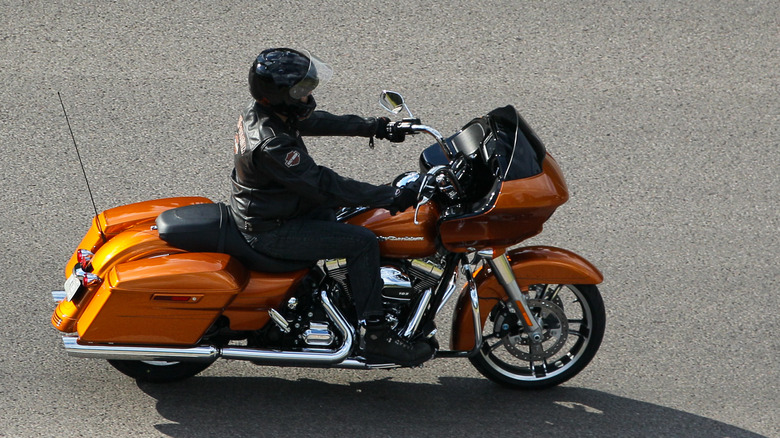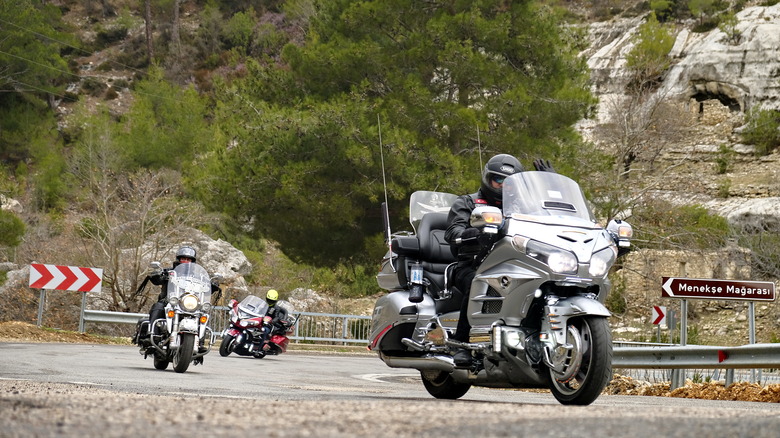2023 Honda Gold Wing Vs Harley-Davidson Road Glide: How Each Touring Bike Compares
In the world of touring bikes, the Honda Gold Wing and Harley-Davidson Road Glide stand out as formidable contenders, each with their own distinct characteristics and allure. As riders embark on journeys spanning long distances, the choice between these two iconic motorcycles becomes a crucial consideration.
Despite their shared commitment to long-distance comfort, these touring bikes diverge at key aspect points. The Road Glide, acknowledged for its heftier build, competes with the robust engine and advanced electronics of the Gold Wing — one of the most reliable Honda motorcycles ever built by our metrics. We have picked performance, design, and tech as criteria to compare and contrast these motorcycles while using reviews from reputed publications like Top Speed as professional primary sources for this article.
In comparing the 2023 Honda Gold Wing and Harley-Davidson Road Glide, we aim to uncover the nuances that set them apart, allowing riders to make an informed decision based on their preferences and the demands of their journeys.
What is the Honda Gold Wing?
The history of the Honda Gold Wing dates back to 1972, when Honda, fresh from the success of the CB750, established an R&D department to create a groundbreaking flagship motorcycle. The project was led by Japanese designer Shoichiro Irimajiri, known for his success in both two and four-wheeled racing. The result was the 1975 Honda Gold Wing, a revolutionary touring motorcycle featuring a four-stroke engine with water-cooling and shaft drive — the Honda Goldwing was the first Japanese production motorcycle with this engine.
At its launch, the Gold Wing was different, offering a blend of speed, reliability, and comfort that set it apart. Despite facing stiff competition from established brands like Harley-Davidson, the Gold Wing gained traction, and in 1980, the GL1100 Interstate elevated it to a new level by becoming the first mass-produced Japanese motorcycle in a complete touring kit.
The evolution continued with the GL1200 in 1984, introducing fuel injection, cruise control, auto-leveling rear suspension, and a trip computer. In 1988, the GL1500 emerged with a six-cylinder engine, setting the stage for constant improvements over 13 seasons. Subsequent years saw steady improvements, including a larger engine in 2001, the introduction of an in-dash navigation system in 2006, and the pioneering addition of an airbag in 2012. This brings us to the 2023 version of the bike, whose specs we will see later. Currently, you can get a brand-new Honda Gold Wing for $25,600.
What is the Harley-Davidson Road Glide?
The Harley-Davidson Road Glide also has a rich history that traces its roots back to the Tour Glide, which was introduced in 1979. The Tour Glide marked a departure with its fixed fairing, distinct from its counterpart, the Electra Glide, which featured a fork-mounted fairing. In 1998, the Tour Glide made way for the Harley-Davidson Road Glide, featuring a frame-mounted Tour fairing reminiscent of the original Tour Glide. This move positioned the Road Glide as a strong contender in the touring motorcycle market.
With the introduction of the Milwaukee-Eight engine in 2016, the Road Glide further solidified its position as a powerhouse in the touring category. Subsequent years saw further refinements, such as changes to fairing mounting supports, the introduction of Cruise Control as an option, and engine enhancements.
The Road Glide's popularity is evident in its continued presence and adaptation to evolving rider preferences. Whether as the Road Glide Special, Limited, Ultra, Custom, or other variations, this touring motorcycle has maintained status as a powerful and reliable touring bike. You can find the standard Road Glide at a price of around $22,000.
Performance
In terms of power, the Gold Wing's flat-six, 1,833cc engine delivers an impressive 125 hp and 125 lb-ft of torque. In contrast, the Road Glide Limited features a Milwaukee-Eight 114 engine with a more significant displacement of 1,868cc but produces 92 hp and 111 lb-ft of torque. While the Road Glide Limited boasts a larger engine, the Gold Wing clearly takes the lead in horsepower and torque, translating to a more robust acceleration.
The top speeds of these touring motorcycles also reflect their design philosophies. The Gold Wing reaches an impressive 140 mph, emphasizing its ability to cover long distances with speed and ease. On the other hand, the Road Glide Limited has a top speed of 105 mph, showcasing a more conservative approach. However, a review by Top Speed confirms that in real-world scenarios, both bikes offer comparable performance, with the Gold Wing's rev-happy nature contrasting the Road Glide Limited's low-end torque.
Handling dynamics play a crucial role in touring comfort, and here, the Gold Wing's design shines, according to Top Speed. Despite being 28 pounds heavier than the Road Glide Limited, the Gold Wing's low center of gravity, thanks to its flat-six engine layout, contributes to a superior level of handling. The Hossack front suspension system enhances stability, eliminating dive under braking. The Road Glide relies on traditional telescopic forks, providing a more straightforward design that works effectively in containing the bike's weight during cornering. The Harley's simplicity might appeal to riders looking for more straightforward handling.
Design and ergonomics
The Honda Gold Wing's design showcases bodywork that contributes to refined aerodynamics, featuring a vented, spoiler-type front fender and substantial fairing that cuts through the wind. The Gold Wing's stadium-style seat for the passenger and practical hard bags enhance its utility for commuting and touring.
Conversely, the Harley-Davidson Road Glide adheres to its classic touring design, drawing on the historical roots of the "FL" family. The front fender's shape echoes the traditional full fender, and fat front forks, with chrome beercan fork skirts, evoke a classic appeal. The fixed Sharknose fairing, a trademark feature since the Tour Glide, integrates dual Daymaker LED headlights.
When it comes to ergonomics, Top Speed reports that both bikes offer all-day comfort with an upright riding position suitable for long distances. The Gold Wing's design suggests thorough wind tunnel testing, emphasizing aerodynamics. On the other hand, while appearing less complicated, the Road Glide provides a comfortable rider triangle. In terms of comfort, the review goes on to say that Harley's seat is often regarded as more comfortable, while both bikes do offer accommodating ergonomics.
The Honda Gold Wing and Harley-Davidson Road Glide, though sharing a touring focus, diverge in their design approaches. The Gold Wing leans more toward innovation, advanced electronics, and a sleek profile, while the Road Glide maintains a classic touring aesthetic with modern infotainment features.
Electronics and tech
When it comes to tech, the Gold Wing takes center stage with a seven-inch color TFT screen as the central hub for all electronics. This includes analog gauges for speed and tach, complemented by LCDs for comprehensive information display. The Gold Wing also has a sophisticated throttle-by-wire system, which features four distinct riding modes: Tour, Sport, Econ, and Rain. Notably, the Honda Selectable Torque Control (HSTC) system deals in rear-wheel slip, and Hill Start Assist simplifies uphill starts. The bike also supports Apple CarPlay and Android Auto.
On the other hand, the Harley-Davidson Road Glide features analog gauges, a color TFT screen, and Boom! Box 4.3 infotainment system. The rider aid package offers hands-free mobile phone connectivity via Bluetooth and voice recognition for various functions. The Boom! Box GTS audio system with GPS and 6.5-inch touchscreen offers navigation, communication, and entertainment options.
When comparing the two motorcycles, the Gold Wing and Road Glide surprisingly share similarities in electronic features. Both incorporate an internal measurement unit (IMU) for cornering ABS and traction control. Linked brakes, cruise control, and hill-hold control are standard on both, promoting rider comfort and safety. However, the Gold Wing distinguishes itself with reverse gear, offering added maneuverability in parking and low-speed situations. The cockpit design also sets them apart, with the Gold Wing embracing a more integrated analog and digital layout, while the Road Glide adopts traditional round analog gauges and a large touchscreen.

